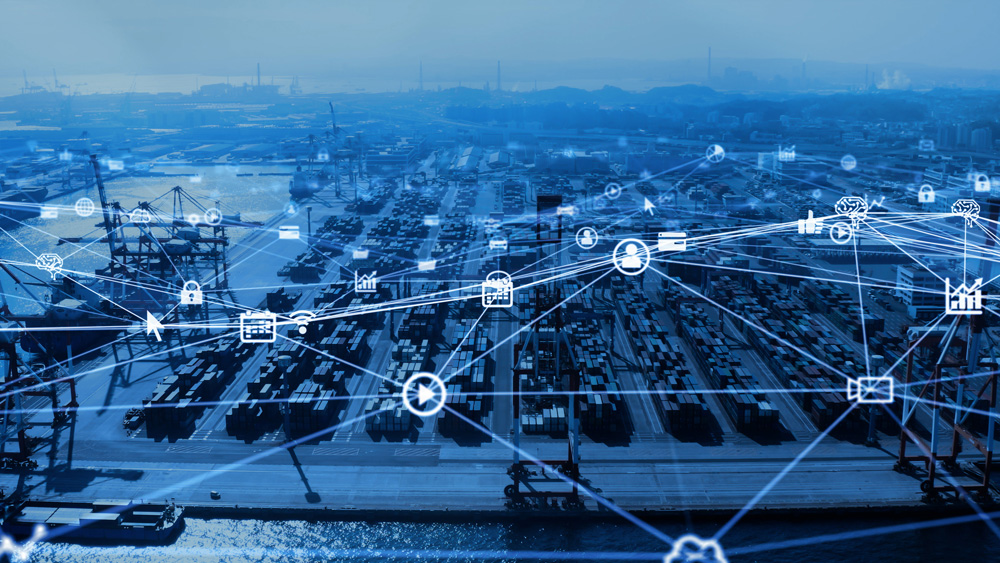
Before your phone can be a source of endless TikTok videos, you must first acquire it through a global supply chain. But when these supply chains are disrupted, whether due to a global pandemic, unexpected winter storms or a massive cargo ship blocking a busy trade canal, it can affect everything from the food you eat to the toilet paper on the shelves of local grocery stores.
Dr. Eleftherios “Lefteris” Iakovou, the Harvey Hubbell Professor of Industrial Distribution at Texas A&M University and director of Manufacturing and Logistics Innovation Initiatives for the Texas A&M Engineering Experiment Station, is utilizing his years of expertise in supply chain research to bolster current supply chains and develop new, resilient supply chain systems. He recently published an extensive look into supply chains and how to build a more resilient system in the United States.
So, what exactly is a supply chain? At its core, it is the network or process involved in the creation and sale of a product to consumers and industrial customers.
Iakovou, also the co-director of the Global Value Chains Program at the Bush School and director of supply chain management for the SecureAmerica Institute of The Texas A&M University System, explained that it is far more intricate than just that, however.
“A supply chain is an extended enterprise over which we do five things: we plan, we buy, we make, we move, we sell,” he said. “Over this extended enterprise, we manage four flows. We manage flows of products, flows of processes, flows of information and financial flows. And unless we do this synergistically, we cannot add value to the supply chain itself.”
Defining disruptions
When one part of this delicately balanced network fails and disrupts the process, the rest of the supply chain — consumers, companies and the nation included — are directly affected.
This can be a disruption in supply or production, such as when a manufacturing plant in Japan is out of commission due to a tsunami; a disruption in demand and supply, as seen with the increased need and lower supply of power during the winter storm in Texas; or a disruption in transportation due to the Suez Canal being blocked by one of the largest container ships in the world — the Ever Given vessel.
He explained that these global supply chains are very brittle and highly susceptible to disruptions, particularly surrounding uncertain or unplanned events. For example, the COVID-19 pandemic demonstrated a lack of preparedness by nations and companies alike for “black swan” (low probability-high impact) events.
“It's one thing to prepare an organization based on chronically occurring disruptions, and it's another thing to think, ‘How can I create a supply chain that is flexible enough, agile enough so when something really bad happens, it has the posture to bounce back as quickly as possible?’” Iakovou said.
The future of resilience
Developing a resilient supply chain starts with understanding that one size does not fit all. Each has its own set of complications and strengths.
In the modern global economy, cost reduction has almost become synonymous with outsourcing and offshoring the manufacturing of components for products. However, it is important for companies to still have home-based manufacturing plants that operate, even at a lower production rate, in case there is an issue with the offshored supply. Iakovou said COVID-19 demonstrated the sole supplier model is out of business.
“Companies are pushing for low cost. Low cost itself is not sustainable,” he said. “The federal government, on the other side, needs resilience and security for supply chains critical to the nation (e.g., pharmaceuticals, semiconductor chips, large capacity batteries, rare earth minerals). But resilience costs money, as it’s based on redundancies (diversified sourcing, additional inventories).”
Iakovou suggests the government has a key role to play.
By transitioning companies away from a shareholder model and into a stakeholder model, as suggested in 2019 by the Business Roundtable, private and government sectors would have to collaborate and consider not only shareholder value, but also workers and associated partners, society, national competitiveness and security, and the environment.
“That's a monumental shift, that, if it happens correctly, would allow for new optimal trade-offs between cost efficiencies, resilience and sustainability,” he said.
Iakovou pointed out that in the past, governmental agencies were critical in de-risking innovations related to the internet, touch screens and vaccines. He believes the government should work with the movers and shakers in society and the private sector to continue to advance similar innovations in supply chains critical to the nation and to further support the nation’s well-being, competitiveness, security and global leadership.
“There is a talk, in my humble opinion deservedly so, about the elevated role of the government as a further catalytic entity, to spur more innovation in the way we design these global supply chains so that they display cost-competitive resilience in order to address the new realities,” he said. “And that's where the stakeholder model would be very handy. So, I absolutely believe that this is the way to move forward.”Supply chain expertise at Texas A&M University
The Texas A&M Engineering Experiment Station and Texas A&M University have a demonstrated history of strong leadership and excellence in fields that affect everyday life, like supply chain management. The Thomas and Joan Read Center for Distribution Research and Education applies both advanced research skills and a thorough understanding of distribution to every project. Their experts, who merge long-standing industry experience with the latest developments in academia, conduct both primary and secondary research for manufacturers, distributors, professional associations and publications. Texas A&M’s Global Supply Chain Laboratory teaches students the importance of a dynamic end-to-end supply chain vision, as well as cutting-edge solutions for wholesale and industrial distribution channels.
